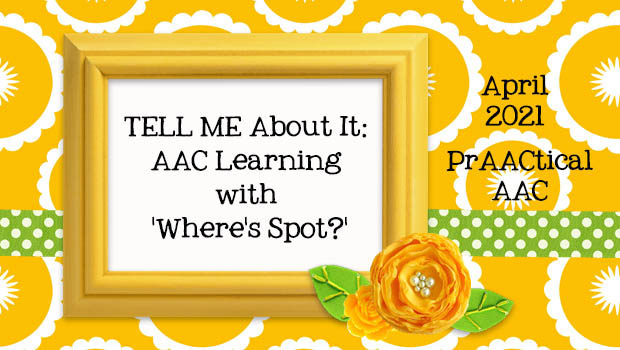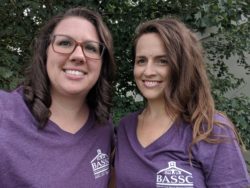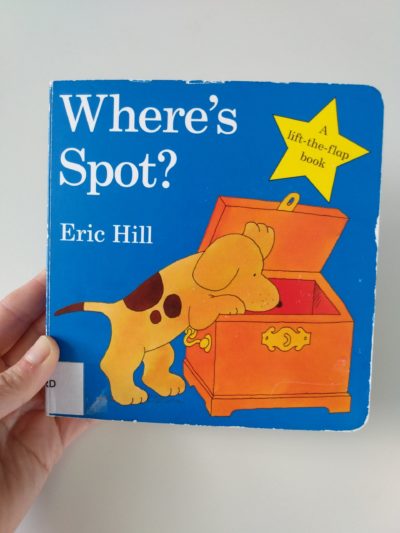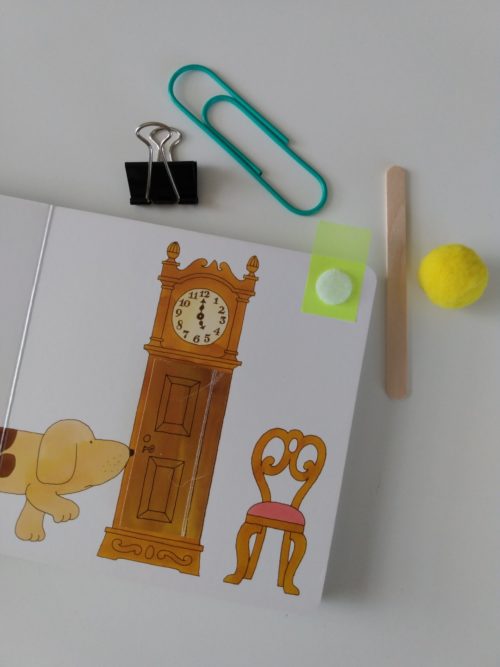TELL ME About It: AAC Learning with ‘Where’s Spot?’

 We’re thrilled that AAC SLPs Maggie Judson and Jeanna Antrim have returned to these pages with another edition in the TELL ME About It series. Maggie and Jeanna are speech-language pathologists who work in the Assistive Technology Department for the Belleville Area Special Services Cooperative (BASSC) in southern Illinois. They are AT/AAC facilitators and provide evaluations, direct therapy, consultations, and trainings with school teams.
We’re thrilled that AAC SLPs Maggie Judson and Jeanna Antrim have returned to these pages with another edition in the TELL ME About It series. Maggie and Jeanna are speech-language pathologists who work in the Assistive Technology Department for the Belleville Area Special Services Cooperative (BASSC) in southern Illinois. They are AT/AAC facilitators and provide evaluations, direct therapy, consultations, and trainings with school teams.
As usual, their post is chock full of prAACtical information including ideas for classroom activities, virtual learning tips, supporting AAC learning at home, and more. Also, don’t miss their tips for supporting a variety of communicative functions and their video read-alouds with three different AAC apps.
If you are new to the series, you can check out their previous posts in the TELL ME About It series below.
- YEAR 1
- YEAR 2
TELL ME About It: AAC Learning with ‘Where’s Spot?’
TELL ME About The Book
The eighth book in this new series is “Where’s Spot?” by Eric Hill. This book is an absolute classic for our young emergent readers! The interactive lift flaps make this book so engaging, and that same interactive element also creates so many communication opportunities and chances to teach those wonderful core words. 
See below for the book focus for “Where’s Spot?”:
Book Focus:
- Core Words (BOW WOW Words): WHERE, NO
- Additional Words (Tiger Talk Words): there, ready
- Concept Vocabulary: prepositions/spatial concepts
- Book Concept: Punctuation
- Special Letters: w, k, x, v, y, z, j, q, a, m
TELL ME About Reading
Repeated Reading Focus: Uppercase/Lowercase Letters
Repeated readings offer an opportunity to work on all sorts of different literacy skills, which is why TELL ME recommends using the same book for two weeks (yay for repetition with variety!). For one of your repeated readings, try providing print referencing for uppercase and lowercase letters. This draws students’ attention to how each letter can be written in different ways and increases their overall knowledge of print. After some practice, you will find that this is an easy technique to add to your growing literacy instruction toolbox!
- After reading a page and pausing, say, “Look. This is an uppercase T (as you point to it). And this is a lowercase t (as you point to it). T, t (as you point to each). They are both T” Then pause again. This pausing provides the student processing time and gives them space to respond.
To learn more about print referencing, check out this module from Shared Reader here.
Adaptation Idea: Page Fluffers
Ensuring books are physically accessible for your students is another important thing to consider when adapting books. Physically accessible books can help students engage more readily with their classroom library and in independent reading. One way to do this is to add page fluffers. Page fluffers make it easier to turn pages, which then makes it easier to interact with books. A page fluffer is essentially anything added to the book that separates the pages slightly or gives a larger area for grabbing and turning.
Here are some easy, quick ideas for page fluffers:
- Paper clips
- Pom Poms
- Bag Clips
- Highlighter Arrows
- Soft velcro dots (try putting them on little sticky notes, so they are removable and reusable for other books! This is helpful if you are using a borrowed book or library book and can not permanently attach page fluffers to it)
To learn more about page fluffers, check out this blog post from PrAACtical AAC here.
TELL ME About Writing
Writing is a big part of a TELL ME classroom! See below for ideas:
Predictable Chart Topic
Title: WHERE is Spot!
Sentence frame: Is he in the ______?
FUNctional Writing Activity
When we first read Comprehensive Literacy for All: Teaching Students with Significant Disabilities to Read and Write (Erickson & Koppenhaver, 2020), we came across the section about creating a ‘welcoming emergent writing community’ in the classroom (don’t you just love that phrase, insert all the heart eye emojis here!). One idea is ‘Big Paper’ (page 72), and we immediately started sharing it with all our teams and during our literacy professional development trainings! Here’s the gist:
- Cover a large table with paper, think bulletin board paper or a long piece of paper from a roll, and provide various writing utensils.
- Everyone gathers around the table. This includes students, teachers, classroom assistants, and any other professional who happens to be in the classroom at the time.
- Start writing, drawing, marking, whatever! Just get writing!
- Students get to observe what others are doing and can try out different tools, topics, and forms that they see.
- Teachers and other educators can easily: demonstrate what they are doing by using talk-alouds and self-talk strategies, commenting on what the students are writing, encouraging students, and offering any needed support.
- Remember that this is a fun, social activity meant to celebrate all attempts at and forms of writing.
- Be excited that you provided a super supportive emergent writing activity!
TELL ME More
Below are some specific ideas on how to implement “Where’s Spot?” in your therapy sessions and classrooms TELL ME-style!
Aided Language Input Tip – Demonstrate a Variety of Communication Functions
Providing aided language input is one of those instructional strategies you will find yourself doing over and over (and over!) again in a TELL ME classroom. Often, when we start learning about aided language input, we might focus on demonstrating one communication function, such as requesting preferred items or activities, as we are learning more and getting comfortable. That is a great approach! But once you have gotten some practice with aided language input, get out of your comfort zone and work in all those other fun functions! Think:
- Requesting assistance
- Directing actions
- Commenting
- Protesting
- Describing
- Asking/answering questions
- Expressing humor
- Gaining attention
- Initiating communication
And that’s just to name a few! Here are some examples of the target core words for “Where’s Spot?”:
- “WHERE should we go this weekend?”
- “THERE are NO more glue sticks.”
- “NO, I’m not READY yet!”
- “Get READY. Get set. Go!”
- Embedding Core into the Daily Routine – Transitions
Transitions between activities or between areas in the school can be a routine-based time within the preschool classroom, making it a natural time to incorporate the target core words into different rote phrases and scripts. Having some predetermined scripts can be a supportive way for communication partners in the classroom to become comfortable with targeting core words and providing aided language input on AAC systems.
Some examples:
- “We are READY to line up to go.”
- “WHERE do you stand?”
- “Yes, right THERE!”
- “I wonder, do we need coats? NO, it is warm outside!”
- Craft – Puppy Cup (PICTURE 4)
- Materials:
- Colored plastic cups or Styrofoam Cups (can then color or decorate)
- Pom Poms
- Construction Paper
- Googly Eyes
- Glue
- Scissors
- Crafts and art projects can be a great way to create communication opportunities! Think of all of the communicative functions, such as requesting desired items, requesting assistance, directing actions, commenting, protesting, describing, labeling, asking/answering questions, that we can elicit and provide aided language input for! Some examples for the craft mentioned above could be:
- “WHERE should we put the eyes?”
- “NO, I want a pink tongue!”
- “Put it THERE.”
- “My puppy is READY to play hide-and-seek!”
- Virtual Learning Resource – The SLP Yogi Virtual Bookshelf
Over the last year, we have totally fallen in love with virtual classrooms, and for a good reason! They are engaging for students and families, provide lots of opportunities to link activities, videos, and materials, and can provide us with a whole lesson or therapy activity! So, we were so excited when The SLP Yogi @theslpyogi shared a virtual library that they created. It is over 20 slides long, organized by topic, and shares YouTube links for So. Many. Awesome. Books!
BONUS Virtual Learning Resources
- Check out Jeanna’s @speechwithoutlimits additional virtual learning resources! WHERE YouTube video, WHERE Boom Deck, NO YouTube video, NO Boom Deck, THERE Boom Deck, READY Boom Deck
- Check out Maggie’s @the.bookish.slp additional virtual learning resource! WHERE digital book
TELL ME at Home
Simple Shared Reading Tip: Verbal Print Referencing
Last month we talked about nonverbal print referencing, which is simply pointing to letters, words, and other print features in the book as you read them. This month, let’s add to that by pairing it with its side-kick, verbal print referencing. Verbal print referencing means you verbally draw attention to the text by commenting as you touch the letter, word, or punctuation. Adding this verbal part provides your child with information about what is interesting about the text. Here are some examples for “Where’s Spot?”
- After reading the title page and pausing, point to the W in WHERE and say, “That’s a W.” Then wait again. This pausing allows your child processing time and gives them space to respond.
- After reading a page and pausing, point to the word NO and say, “Look. This word says NO.”, then pause again.
- After reading a page and pausing, say, “Look. This is a ? (as you point to it). We put a ? at the end of a question.” Then provide more wait time.
To learn more about print referencing, check out this module from Shared Reader here.
Self-Reflection Tip
Adults Model Language Using AAC
The TELL ME program is all about helping us as educators develop good AAC teaching practices and routines that we can implement when planning other lessons. But to do this, we have to reflect on how we are providing instruction. Last month, we talked about providing aided language input for communication breakdowns, during classroom routines such as outdoor play, and of course during reading and writing activities!
This month, reflect on those suggestions with the question “adults model language using AAC” from the fidelity checklists available in the TELL ME program.
After reflection, would you answer this question as:
- ALWAYS
- SOMETIMES, or
- RARELY?
If after thinking about the past month you answer this as SOMETIMES or RARELY, that’s okay! We all start somewhere! We encourage you to think through what changes you can make to your teaching practices and routines to support your classroom assistants as they develop their skills to actively facilitate student learning.
Because remember: self-reflection and receiving constructive feedback helps you plan for your next session and get better at providing TELL ME-style instruction!
Video Read-alouds
Check out the videos of us reading the book “Where’s Spot?” while providing aided language input.
Snap Core First
LAMP Words for Life
TouchChat with WordPower
———————————————————————————————————————
Be sure to check back next month as we work through the TELL ME manual and share activities, teaching strategies and implementation tips for the next book in this new series, “I Like Myself!”
RESOURCES and REFERENCES
Erickson, K., & Koppenhaver, D. (2020). Comprehensive Literacy for All: Teaching Students with Significant Disabilities to Read and Write. Baltimore, MA: Paul H. Brookes Publishing Co.
Aided Language Stimulation video – Icpsat: https://www.youtube.com/watch?v=flFNMky22-U&feature=emb_logo
You can purchase the TELL ME manual from the Attainment Company or from ASHA (bit.ly/2XF1w1r).
You can learn more about the program by watching the webinar TELL ME: AAC for the Preschool Classroom presented by Dr. Carole Zangari, available from Saltillo (bit.ly/2RNpykn).
Follow us on Instagram @basscAAC and subscribe to our YouTube channel (basscAAC) for more AAC implementation ideas!
Filed under: Featured Posts, PrAACtical Thinking
This post was written by Carole Zangari
